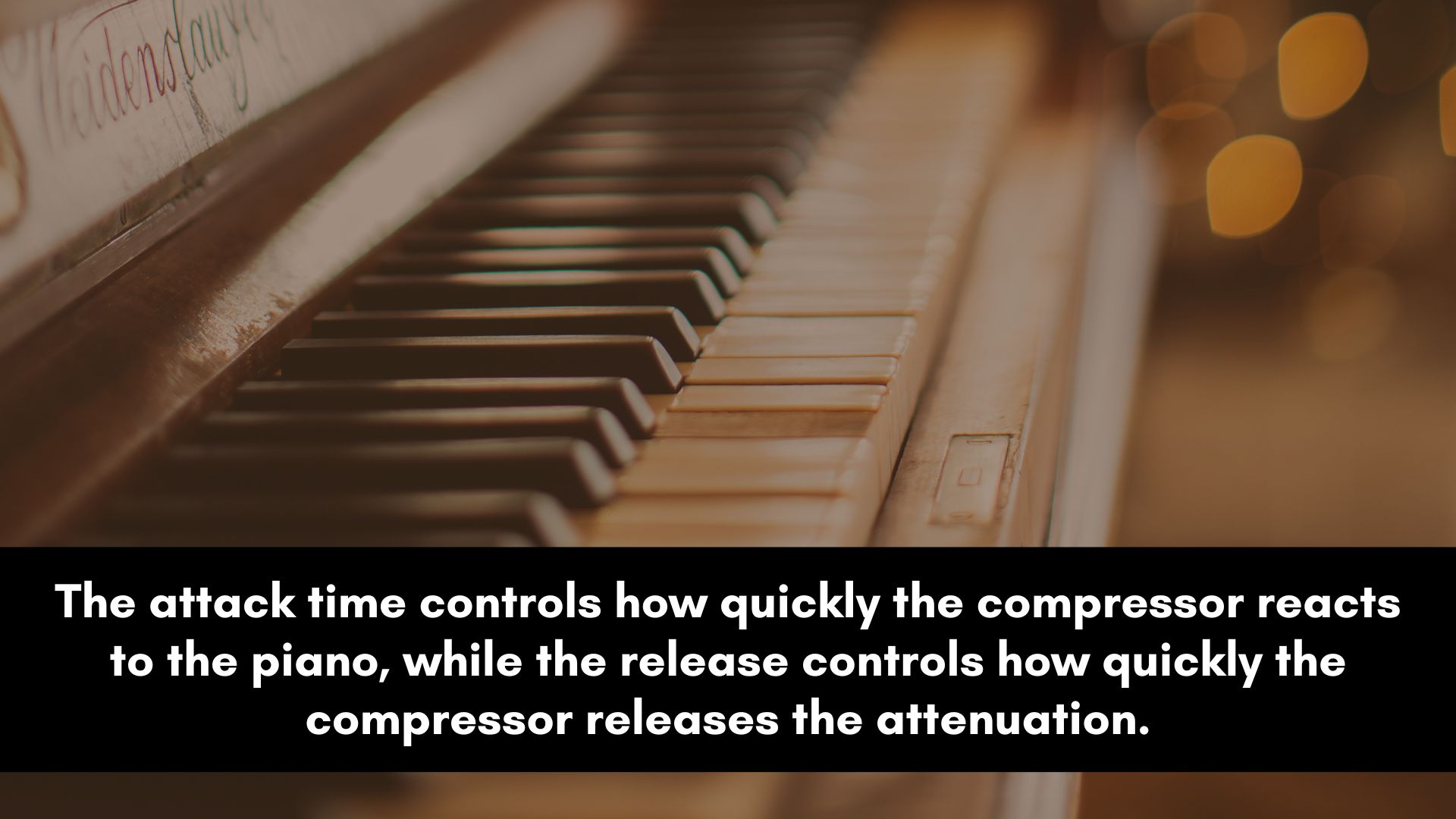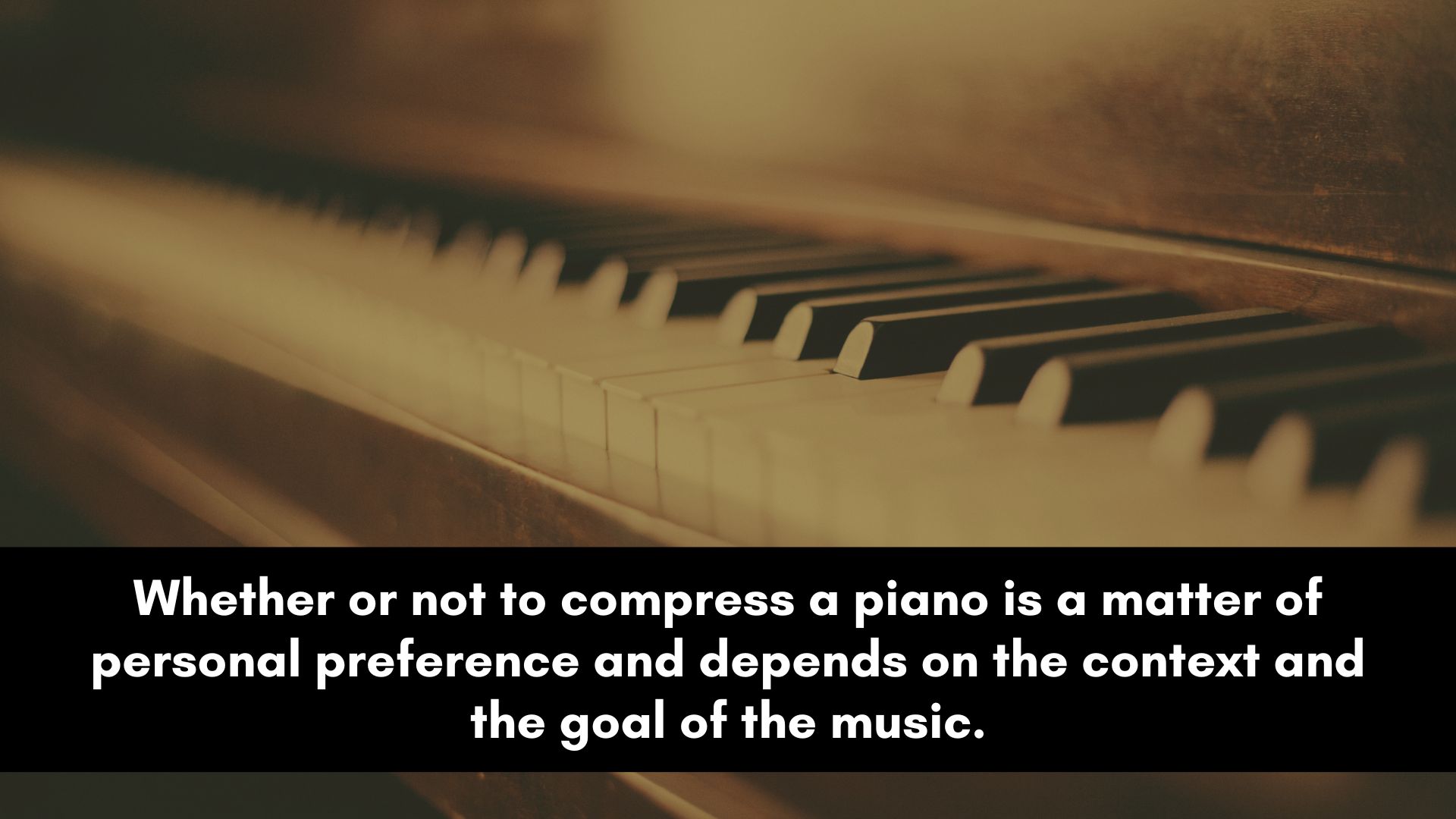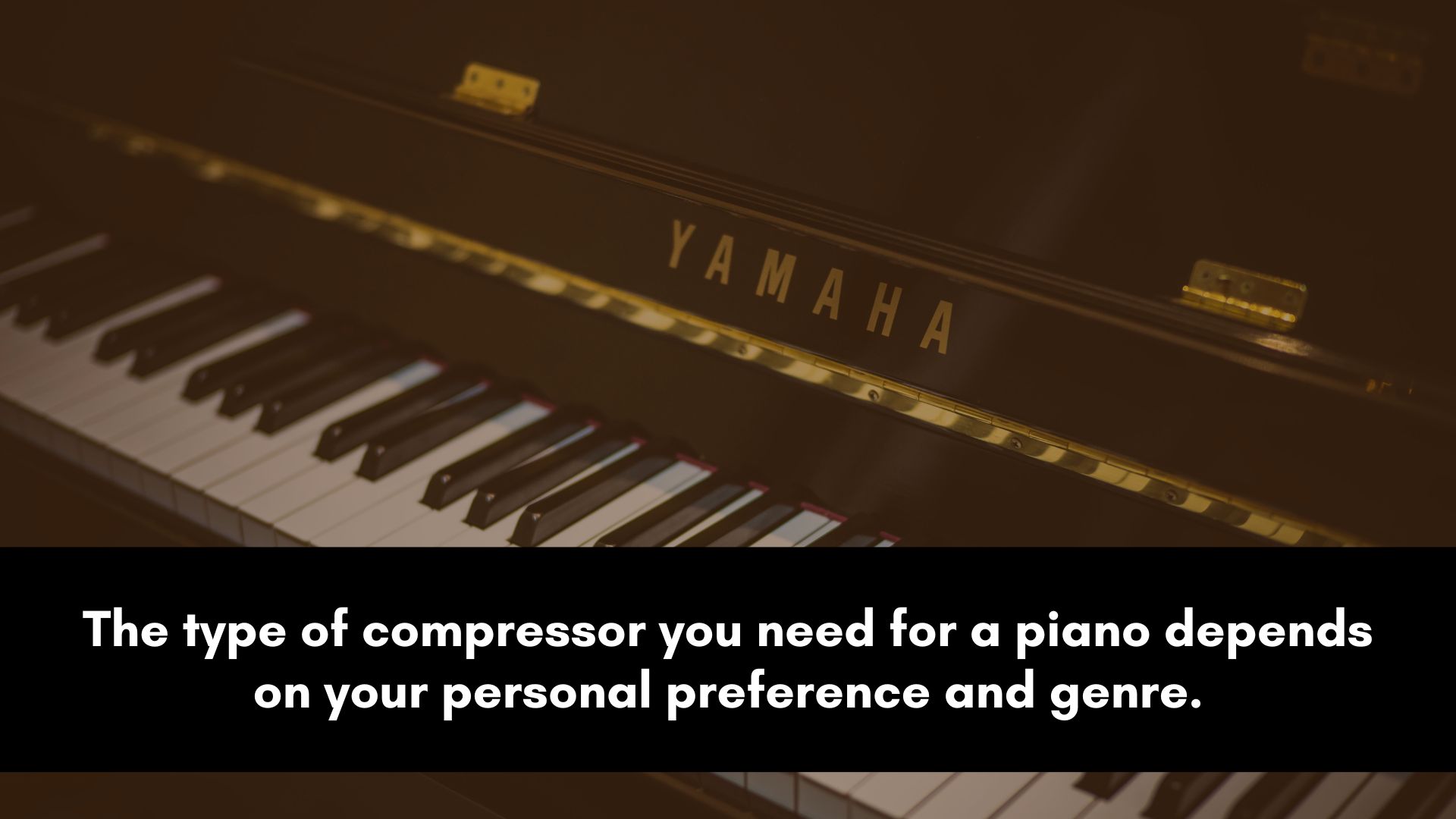If you have ever recorded or mixed piano music, you may have encountered some challenges in balancing the dynamic range of the instrument.
Unlike many electronic or amplified instruments, such as the guitar or synthesizer, the piano has a wide range of sound levels and timbres that can vary from note to note, chord to chord, and passage to passage.
To make the piano sound consistent and coherent, you need to use some form of dynamic control, such as compression.
This can help increase the perceived loudness, sustain, and clarity of the piano while also reducing the risk of clipping, distortion, or unwanted resonance.
However, compression is not a magic bullet that can solve all problems, and it requires some understanding of the piano's characteristics and the compressor's parameters.
Piano Compression Settings (Step-by-Step)
In case you still don’t fully understand compression and are still relying on guesswork, check out my previous post titled "How to Use a Compressor" before reading this one.
Here are some tips and techniques for effectively compressing piano:
Choose the Right Type of Compressor

The first step is to choose the right type of compressor. Not all compressor units or plugins are built the same or designed for the same purpose.
There are many types of compressors, each with its own distinct sound, behavior, and controls.
Some common types are optical, VCA, FET, and tube compressors.
Optical compressors tend to be smooth and transparent. This type is great for various situations, but mostly for controlling dynamics and making the piano sound smooth.
VCA compressors can be fast and precise. These are useful if you’re going for a more aggressive piano sound.
FET compressors are known for being very fast, but they also add some color and character. This makes them perfect for controlling loud peaks and transients and adding presence.
Tube compressors tend to add warmth and saturation. They’re often used in a group of sounds or the entire mix to glue everything together.
Try different compressors and see which one fits your piano sound and fits well with the style of music that you’re currently working on.
Set the Attack and Release Times Carefully

The attack time controls how quickly the compressor reacts to the incoming signal, while the release time controls how quickly the compressor releases the attenuation.
For piano, you may want to use a fast attack time (e.g., 0.1–10 ms) to catch the initial transient of each note but not so fast that it kills the attack or transient.
Unless that's the sound you want and you want to push the piano to the back of the mix.
The release time can be slower (e.g., 200–500 ms) to allow the natural decay of the notes to come through, but not so slow that it blurs the rhythm or causes the sustain to overlap into the next note.
If the release is too fast, that could cause an unpleasant pumping effect.
The settings above are useful when the piano is playing sustained chords.
If it’s playing percussive notes (like a solo), then you may want to experiment with a fast to medium attack and fast release times.
Adjust the Ratio and Threshold Settings Wisely
The ratio determines how much the signal is attenuated when it exceeds the threshold, while the threshold determines at which level the compression starts to kick in.
When compressing piano, you may want to use a moderate ratio (e.g., 2:1 to 4:1) that compresses the louder notes but still leaves the quieter ones unaffected.
This will keep the piano consistent throughout the entire mix without making it sound unnatural.
The threshold can be set at a level that captures the average level of the piano playing, but not too low that it catches too much noise or too high that it misses some of the dynamics.
Use Parallel Compression for More Control and Depth
Parallel compression is a technique that blends a compressed signal with an uncompressed signal.
This can allow you to retain some of the original dynamics and transients while also adding some sustain and weight to the piano.
All you need to do to apply parallel compression is send a duplicate track to a bus or an aux track.
Apply heavy compression to the parallel track, and then mix the two signals together with a balance that suits your taste.
Don’t make it sound too obvious; less is more.
However, this technique can be overkill, especially for a piano sound that is playing a supportive role in a mix.
Listen Critically and Adjust to Taste
Compression is not a one-size-fits-all solution, and its effect on the piano can be subtle or drastic, depending on the context and the goal.
Therefore, it is important to listen to the compressed sound in the mix, solo, and from different speakers, and adjust the compressor's settings accordingly.
You may need to tweak the attack and release times, the ratio and threshold, the makeup gain, and other parameters until you achieve the desired balance between the piano's natural expression and the compression's control.
FAQ About Compressing a Piano
Now that I have the step-by-step process covered, in the next section I’ll be answering some common questions about the topic at hand.
If you have a question that’s not included below, please post it in the comments below, and I’ll definitely answer it.
Should a Piano Be Compressed?

Whether or not to compress a piano is a matter of personal preference and depends on the context and the goal of the music.
Some musicians and engineers prefer the natural dynamic range and expression of the piano and avoid using compression or any other form of dynamic control.
This is a common thing in genres such as jazz, folk, and other acoustic styles of music.
Others use compression to enhance the consistency, clarity, and impact of the piano, especially in genres or situations where the piano needs to compete with other instruments or sounds.
Compressing a piano can help to balance the levels of the notes, chords, and passages and make them more audible and distinct throughout the entire song.
It can also help to tame some of the harsh or resonant frequencies that may occur in certain registers or at high velocity.
Furthermore, compression can increase the perceived loudness of the piano without increasing its actual volume, which can be useful for recordings or live performances where the piano needs to cut through the mix.
However, compressing a piano can also affect its natural tone, decay, and resonance, and may introduce some artifacts or distortions that can be undesirable.
This can make it sound less nuanced or emotional.
Therefore, if you decide to compress a piano, it's important to do so in a way that respects the natural sound and character of the instrument and that enhances rather than detracts from the musical performance.
What Kind of Compressor Do I Need for the Piano?

The type of compressor you need for a piano depends on your personal preference.
The genre or style of music you're working on plays a big role, as do the specific characteristics of the piano you're recording or mixing.
Different types of compressors have different sonic qualities, dynamic responses, and controls that can affect the way the piano sounds and behaves.
Here are some common types of compressors and their potential use cases for piano:
Optical compressors: an opto tends to have a smooth and transparent sound that can work well for gentle and natural compression. They are often used in jazz, classical, and acoustic music.
VCA compressors: A VCA produces a fast, precise sound that can work well for aggressive and rhythmic compression. It’s mostly used in rock, pop, and electronic music.
FET compressors: A FET has a colored and aggressive sound that can work well for adding some edge and bite to the piano. It’s usually used in funk, soul, and blues music.
Tube compressors: These compressors, also known as Vari-Mu, tend to have a warm, saturated sound that can work well for adding some richness and depth to the piano. They are normally used in jazz, blues, and vintage-style music.
Of course, these are generalizations, and there are many varieties and hybrids of compressors that can fit different scenarios.
Ultimately, the best way to find the right compressor for your piano is to experiment with different types and models and listen to how they affect the piano in your mix.
Try to find a compressor that enhances the natural tone, expression, and emotion of the piano rather than one that flattens or masks them.
Piano Compression Cheat Sheet
Here’s a quick cheat sheet that you can use to get a solid starting point.
This should help you avoid relying on guesswork whenever you’re mixing piano.
Dynamic Control: If you’re working on a piano sound that’s too dynamic, use a fast to medium attack, medium release, 4:1 ratio, hard knee, and high gain reduction.
Tonal Control: When the piano is not too dynamic but requires a small amount of tonal control, use a medium to slow attack and release, a 1.5:1 to 3:1 ratio, a soft knee, and low gain reduction.
Transient Control: To control loud peaks or transients, apply a fast attack and release, a +5:1 ratio, a soft knee, and set gain reduction to only affect the loud transients.
Punch: To make the piano sound punchy, use a slow attack, medium to slow release, 3:1 ratio, soft knee, and low gain reduction.
Remember, this is a starting point. You’ll still need to adjust the settings a bit to make the piano fit your particular mix.
You can even set these settings as presets to make your workflow a lot faster.
Get the complete compression cheat sheet below.